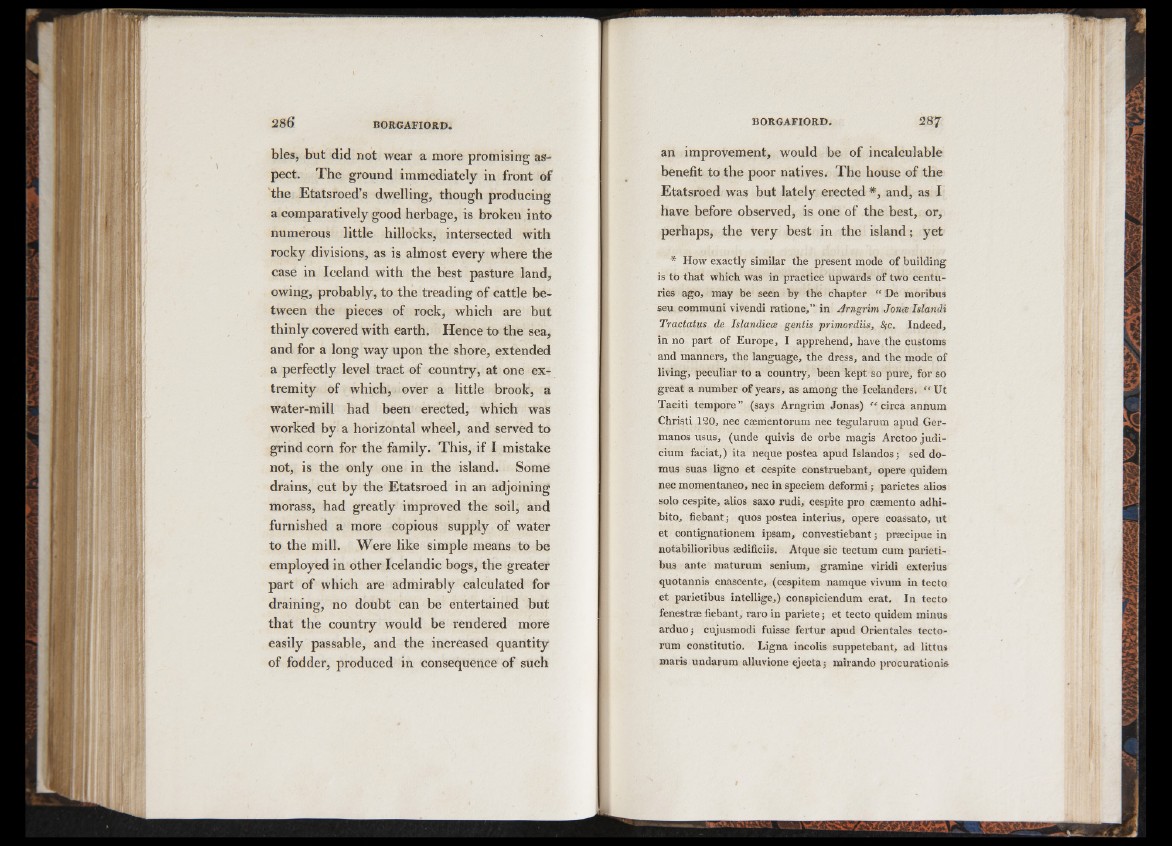
bles, but did not wear a more promising aspect.
The ground immediately in front of
the Etatsroed’s dwelling, though producing
a comparatively good herbage, is broken into
numerous little hillocks, intersected with
rocky divisions, as is almost every where the
case in Iceland with the best pasture land,
owing, probably, to the treading of cattle between
the pieces of rock, which are but
thinly covered with earth. Hence to the sea,
and for a long way upon the shore, extended
a perfectly level tract of country, at one extremity
of which, over a little brook, a
water-mill had been erected, which was
worked by a horizontal wheel, and served to
grind corn for the family. This, if I mistake
not, is the only one in the island. Some
drains, cut by the Etatsroed in an adjoining
morass, had greatly improved the soil, and
furnished a more copious supply of water
to the mill. Were like simple means to be
employed in other Icelandic bogs, the greater
part of which are admirably calculated for
draining, no doubt can be entertained but
that the country would be rendered more
easily passable, and the increased quantity
of fodder, produced in consequence of such
an improvement, would be of incalculable
benefit to the poor natives. The house of the
Etatsroed was but lately erected *, and, as I
have before observed, is one of the best, or,
perhaps, the very best in the island ; yet
* How exactly similar the present mode of building
is to that which was in practice upwards of two centuries
ago, may be seen by the chapter “ De moribus
seu communi vivendi rat ione,” in Arngrim Jorue Islandi
Tractatus de Mandicce gentis primordiis, 8;c. Indeed,
in no part of Europe, I apprehend, have the customs
and manners, the language, the dress, and the mode of
living, peculiar to a country, been kept so pure, for so
great a number of years, as among the Icelanders. “ Ut
Taciti tempore” (says Arngrim Jonas) “ circa annum
Christi 120, nee caementorum nee tegularum apud Ger-
manos usus, (unde quivis de orbe magis Arctoo judicium
faciat,) ita neque postea apud Islandos; sed do-
mus suas ligno et cespite construebant, opere quidem
nee momentaneo, nee in speciem deformi ; parietes alios
solo cespite, alios saxo rudi, cespite pro caemento adhi-
bito, fiebantj quos postea interius, opere coassato, ut
et contignationem ipsam, convestiebant j praecipue in
notabilioribus aedificiis. Atque sic tectum cum parieti-
bus ante maturum senium, gramine viridi exterius
quotannis enascente, (cespitem namque vivum in tecta
et parietibus intellige,) conspiciendum erat. In tecto
fenestrae fiebant, raro in pariete ; et tecto quidem minus
arduo -, cujusmodi fuisse fertur apud Orientales tecto-
rum constitutio. Ligna incolis suppetebant, ad littus
maris undarum alluvione ejecta j mirando procuration!»